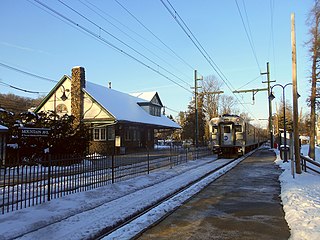
Montgomery County is a county located in Southeast Kansas. Its county seat is Independence, and its most populous city is Coffeyville. As of the 2020 census, the county population was 31,486. The county was named after Richard Montgomery, a major general during the American Revolutionary War.

Labette County is a county located in Southeast Kansas. Its county seat is Oswego, and its most populous city is Parsons. As of the 2020 census, the county population was 20,184. The county was named after LaBette creek, the second-largest creek in the county, which runs roughly NNW-SSE from near Parsons to Chetopa. The creek in turn was named after French-Canadian fur trapper Pierre LaBette who had moved to the area, living along the Neosho River, and marrying into the Osage tribe in the 1830s and 1840s.

Gridley is a village in McLean County, Illinois, United States. The population was 1,456 at the 2020 census. It is part of the Bloomington–Normal Metropolitan Statistical Area.

Chetopa is a city in Labette County, Kansas, United States. As of the 2020 census, the population of the city was 929. Chetopa was named for Chief Chetopah, an Osage Indian chief. Later, the community name was shortened.

Oswego is a city in and the county seat of Labette County, Kansas, United States, and situated along the Neosho River. As of the 2020 census, the population of the city was 1,668.

Parsons is a city in Labette County, Kansas, United States. As of the 2020 census, the population of the city was 9,600. It is the most populous city of Labette County, and the second-most populous city in the southeastern region of Kansas. It is home to Labette Community College and the Parsons State Hospital & Training Center.

Cherryvale is a city in Montgomery County, Kansas, United States. As of the 2020 census, the population of the city was 2,192.

Owasso is a city in Rogers and Tulsa Counties in the U.S. state of Oklahoma, and the largest northern suburb of Tulsa. The population was 39,328 persons as of the 2022 census estimate, compared to 28,915 at the 2010 census, a gain of 36 percent. Originally settled in 1881 in Indian Territory, the town was incorporated in 1904 just before Oklahoma statehood and was chartered as a city in 1972.

The Bender family, more well known as the Bloody Benders, were a family of serial killers in Labette County, Kansas, United States, from May 1871 to December 1872. The family supposedly consisted of John Bender, his wife Elvira, their son John Jr., and their daughter Kate. Contemporary newspaper accounts reported that the Benders' neighbors claimed John Jr. and Kate were actually husband and wife, possibly via a common-law marriage.

The Abilene and Smoky Valley Railroad (A&SV) is a non-profit heritage railway located in Abilene, Kansas, United States. The A&SV is an experiential learning museum, where tourists ride on a train of vintage railcars while narrators tell the story of how railroads built Kansas’ agribusiness-oriented economy. Passengers are allowed to tour antique passenger cars and talk with staff members about their roles in making the trains operate.

Annandale is the penultimate station heading westbound on New Jersey Transit's Raritan Valley Line, located in the Annandale section of Clinton Township in Hunterdon County, New Jersey, United States. The station is located just off interchange 18 of Interstate 78 at the junction of Main Street and East Street. The final stop before High Bridge, it has one low-level side platform, with a shelter, 77 parking spaces and bicycle racks.

Mountain Avenue is an active commuter railroad station in the township of Montclair, Essex County, New Jersey. Serving trains of NJ Transit's Montclair-Boonton Line, Mountain Avenue is one of six stops in the municipality. The next station to the south/east is Upper Montclair. The next station to the north/west is Montclair Heights. Mountain Avenue contains two low-level side platforms. The station depot built by the Erie Railroad stands on the inbound platform, offering a waiting room for commuters. Part of the depot is also leased by the municipality for a residence.
Cropsey is a small unincorporated community in McLean County, Illinois, United States. It was named for a Civil War colonel in the Union Army.

Radburn is a New Jersey Transit train station in the Dutch Colonial Revival style, served by the Bergen County Line. It is on Fair Lawn Avenue in the Radburn section of Fair Lawn, in Bergen County, New Jersey, United States. It is one of two New Jersey Transit train stations in Fair Lawn, the other being Broadway.

Labette Community College (LCC) is a public community college in Parsons, Kansas, United States. LCC's main campus is situated in Parsons and satellite campuses are located in Cherokee, Oswego and Pittsburg. The mascot of the school is Chris the Cardinal. The official school colors are red and white.

Oswego Community Hospital (OCH) was a federally and state-designated 12 bed critical access hospital located in Oswego, Kansas, and one of several hospitals that fell victim to an alleged fraudulent billing scheme that the U.S. Department of Justice says was executed by EmpowerHMS, the hospital's former operator.

U.S. Route 59 (US-59) is a part of the U.S. Highway System that runs from the Mexico–US border in Laredo, Texas, as a continuation of Mexican Federal Highway 85D north to the Lancaster–Tolstoi Border Crossing on the Canada–US border, where it continues as Manitoba Highway 59. In the U.S. state of Kansas, US-59 is a main north–south highway that travels from Chetopa to Atchison.

Plum Grove is a ghost town in Butler County, Kansas, United States. It was located in a rural area north of modern-day Potwin. No buildings remain at this former community site.

K-101 is a ten-mile-long (16 km) state highway in Labette County in the U.S. state of Kansas. The southern terminus is at U.S. Route 166 (US-166) south of Edna, and the northern terminus is at US-160 west of Altamont. K-101 mostly passes through farmland except the section within Edna.

Kansas's 15th Senate district is one of 40 districts in the Kansas Senate. It has been represented by Republican Dan Goddard since 2017; Goddard lost renomination in 2020 to Virgil Peck Jr.






















